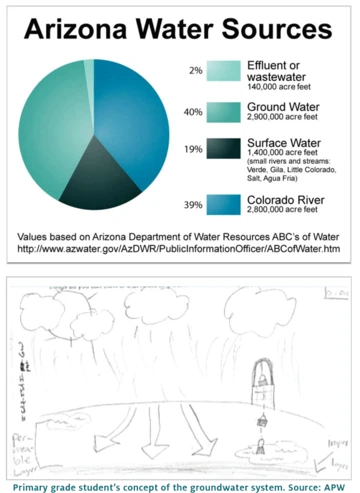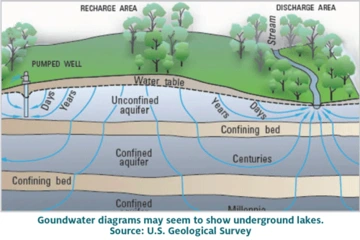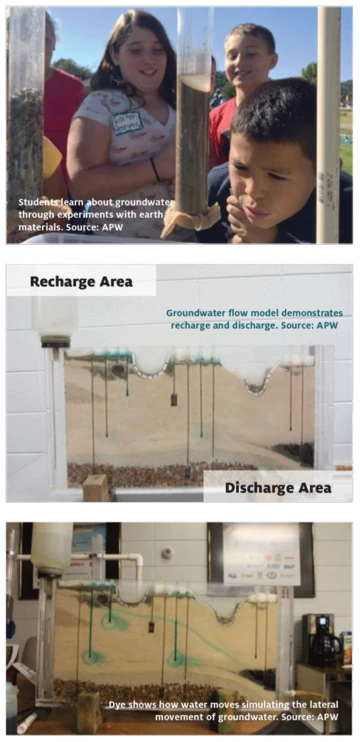 by Kerry Schwartz, Arizona Project WET
by Kerry Schwartz, Arizona Project WET

According to National Groundwater Association’s Facts about Global Groundwater Usage (Oct. 2016), groundwater provides almost half of all drinking water worldwide and supports 38 percent of irrigated lands globally. Unseen beneath our feet, it remains not only the least understood part of the water cycle but the least considered. In a state where over 40 percent of the water supply comes from groundwater, Arizona Project WET (APW) set out to make groundwater visible through education.
Through pre-lesson questionnaires APW was able to assess prior knowledge. In primary grade students, we saw that they just never had thought or heard about the groundwater system. Using pre- and post-lesson questionnaires with older students, teachers, and adult volunteers, we saw that not only were there huge misconceptions about the groundwater system, but they were difficult to change. Turning our attention to how people learned about the groundwater system, we found three main pathways: 1) they never did learn about the groundwater system, 2) they were taught through analogies or 3) they were taught with textbook diagrams.
An analogy is a comparison between two things, typically on the basis of their structure and for the purpose of explanation. Analogies connect to a person’s prior knowledge offering an opportunity to build on that understanding and as such can be a useful tool to introduce learning on a particular topic. But when we use observations about water on the earth’s surface to explain something that is underground, analogies can backfire. When we say, “It’s like a river or a lake underground,” it ties in to what we already know, but solidifies an erroneous picture of what water looks like underground and how it moves. Our analogies are one source of misconceptions about the groundwater system.
Diagrams in textbooks provide a visual image for understanding a system that you can’t see, but they often imprint that image in the mind of the learner providing a strong association between image and reality. When the groundwater is depicted in textbooks and most other scientific diagrams as a blue lake underground, people believe that image equals reality. When foundational knowledge is incorrect, it’s difficult to dislodge or redirect. So even today, textbooks and scientists’ depictions are leading learners astray.

As you can see, the team at Arizona Project WET had our work cut out for us. We knew that we had to start with the simplest most basic concepts. By pouring water down through open-ended tubes filled with earth materials, learners can make predications and then observations. They observe not only that water moves through both gravel and sand, but how it moves through: through the spaces, the “pore spaces”.
At a somewhat more sophisticated level, groundwater flow models help us to see groundwater as a system. Observations of parts include: gravel and sand, clay and silt, input areas called recharge areas and output areas called discharge areas, and water. Given that set of parts, the first question that we always ask is: Where is the groundwater? This is a difficult question because it’s hard to observe. Eventually learners have to acknowledge that groundwater is clear, not blue as in the textbooks. And though this seems self-evident, dispelling misconceptions often requires “seeing it with your own eyes.” Learners come to understand that the groundwater is between the grains of sand and gravel just the way it was in the earth material tubes experiment. That is a big idea! Groundwater is between the grains of sand and gravel (earth materials) and it is not a big lake underground. In systems thinking parlance this is called making a distinction.
The most productive groundwater units or aquifers are sand and gravel systems like we have here in Southern Arizona in the Basin and Range Province. The question: Where does groundwater come from? elicits the answer “rain” sooner or later. And the follow up question, Where does it rain most often around here? gets us to the mountains, the source of our mountain front recharge. The bottle on the left side of the model simulates this mountain front recharge and, using dye, we can observe what the groundwater is doing. Learners observe that it is moving and it is moving in a particular direction, proof that groundwater is not a big lake underground and groundwater is moving laterally and from higher areas to lower areas. This is another big idea! 
A smaller model, with parts that represent gravel, the land surface, a well and a lake, helps learners explore other aspects of the groundwater system. We use sentence starters to drive thinking, challenging students to make observations that assist them in completing the sentences.

Water below the land surface is called … groundwater. When I make it rain on the land surface …. the groundwater level goes up and water comes into the lake. When I pump the well … water comes from the groundwater and is pumped into the container. When I pump groundwater out … the groundwater level goes down and the water level in the lake goes down. Learners are then asked to tell us the relationship between groundwater and lake water. Then we ask an even deeper thinking question: What system is the groundwater system a part of?
Through our work at APW, we know that a third grader can name processes that drive the water cycle: evaporation, condensation, precipitation. But all of that happens in the atmosphere; what are the processes that connect the atmosphere to the land? Some teachers do teach the processes of flow and collection, but very few teachers include infiltration and percolation; processes that connect the surface water and groundwater systems and necessitate the inclusion of groundwater as part of the water cycle.
Lastly, research shows that even when students understand all of the parts of the water cycle, they still tend not to see themselves as within, part of, and dependent upon it. So we ask them: Why do we care about the groundwater system, this system that we can’t even see? They pump wells in both models demonstrating how water is extracted from the ground. Students come to realize that people need groundwater; that is, at least half the people in the world.
We use simple questions to drive inquiry and exploration. Learners make distinctions, divide concepts into parts, assemble parts into wholes, and connect ideas through relationships. Breaking down the concepts into observable phenomena helps learners to debunk their misconceptions about the groundwater system and build new understanding. They get that groundwater…
- is between the grains of sand and gravel.
- moves because gravity works underground just as it does above ground.
- is connected to surface water.
- is part of the water cycle.
- is an important part of our water supply.
 Exploration and discovery around these five basic concepts shift misconceptions and build a strong foundation for understanding the water resource issues and problems that face us today.
Exploration and discovery around these five basic concepts shift misconceptions and build a strong foundation for understanding the water resource issues and problems that face us today.

